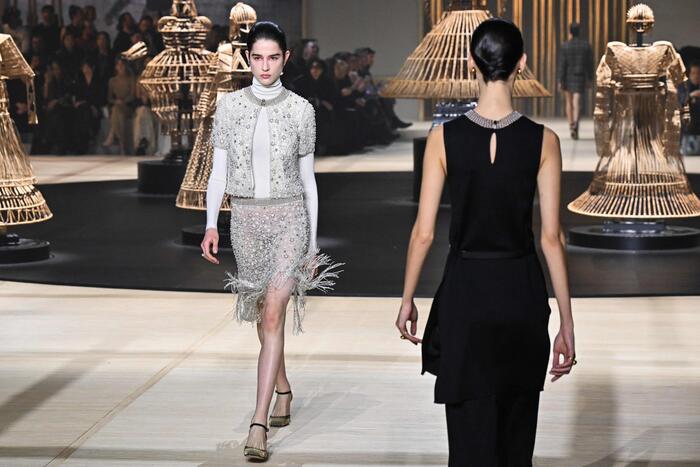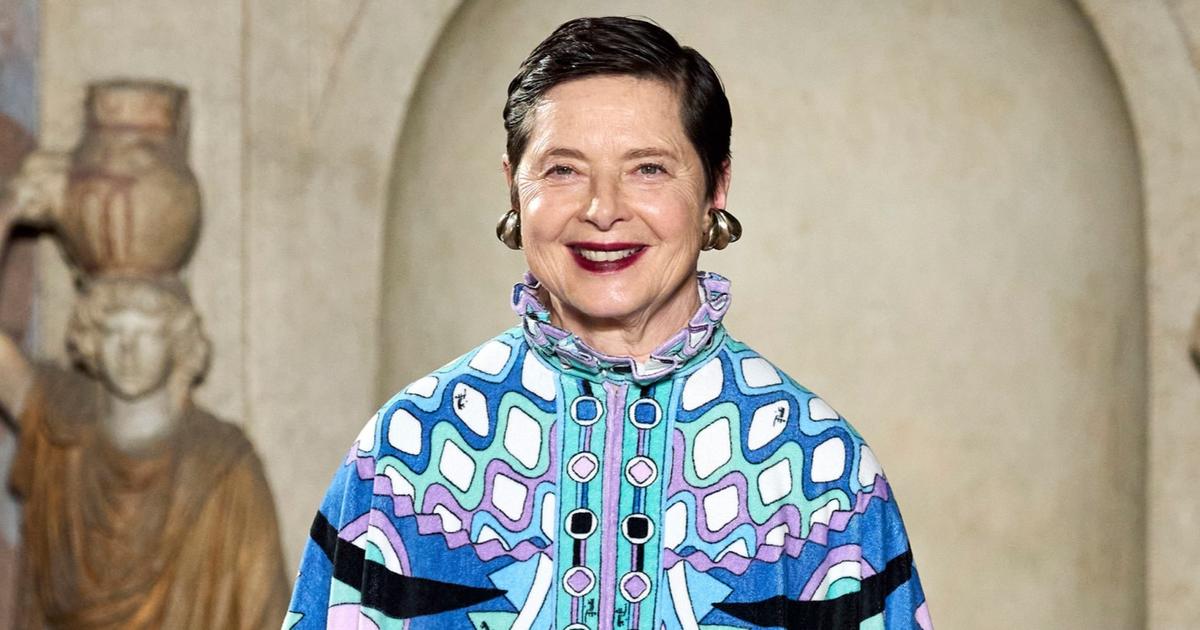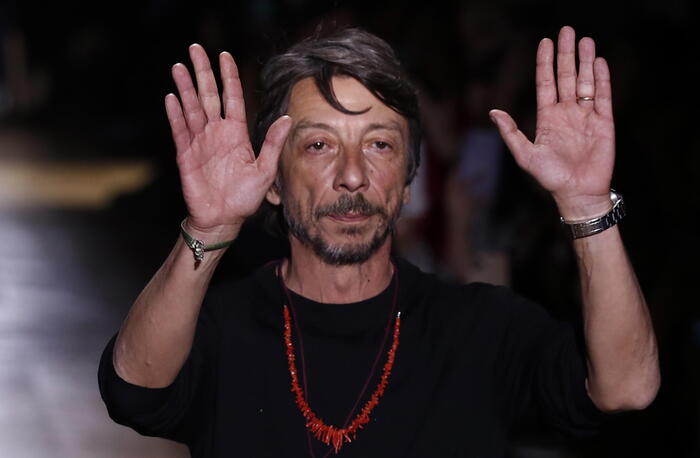The designer Manuel Fernández (Barcelona, 60 years old) fulfilled one of his dreams in 2000, in his debut at New York Fashion Week.
“It was either New York or Paris, but my goal was to parade outside of Spain,” recalls the couturier on a sunny September morning in the living room of his Madrid apartment.
The ROOTS collection became the international launch of this promising designer, a contemporary of Sybilla and Josep Font, who was his duo in his beginnings on the Gaudí catwalk.
And Fernández, who would become the first Spanish creator in this prestigious international event, brought his entire stylistic arsenal to the New York catwalk, where Martina Klein, Nieves Álvarez, Marian Reyes and Lucía Hoyos paraded for him, among other great Spanish models. of the moment, with fringed appliqués on the high boots,
That fantasy had been forged since her first years of life, among fabrics, dresses and remnants from the workshop of her mother Lola, a bespoke dressmaker in Benidorm, who gave her the best advice and also the indispensable condition to be able to study. and devote himself to fashion.
"She told me that if I wanted to go to Barcelona to study design, she had to learn pattern making," recalls Fernández.
Today, almost 40 years after completing his Higher Studies in Fashion Design and Industrial Patternmaking at the Escuela Guerrero in Barcelona, having paraded up to five times in New York and founding his Fashion Art Institute —with which he seeks to encourage interaction between artists plastics and fashion design—, receives the 2022 Brilliant Needle award in Valencia.
The award is given to him by the Artisan Guild of Tailors and Dressmakers CV for his career and “his firm commitment to fashion and sustainability”, according to the official statement.
“It is an honor to receive it after so many great names that preceded me”, alludes the designer about the previous winners, creators such as Elio Berhanyer, Francis Montesinos, Lorenzo Caprile and Roberto Diz.
More information
The 2030 Agenda, pinned to the sleeves of a kimono and a bata de cola
That pattern making that he learned and assures has never fascinated him, it was essential for him to open his first business in 1983, a clothing store in Barcelona of his Trazos brand —“I was the pattern maker there,” he admits laughing—, and it has also helped him to promote other projects that came after the catwalk seasons in Cibeles and New York, a maelstrom that, he confesses, stopped entertaining and appealing to him.
“It no longer occurs to me to make custom-made clothes, except for some special case, such as a wardrobe for my
sister
Loles León.
I am in other stories, much more conceptual projects.
For me now it is essential that something has a reason behind it”, reflects Fernández.
The model María Reyes during the parade of the collection of the Spanish designer Manuel Fernández for spring 2001 in New York.
Miguel Rajmil (EFE)
And one of those whys, essential for Manuel, is the defense of sustainability from within the second most polluting industry, after aeronautics.
“The biggest problem is ourselves, buying like crazy very cheap clothes.
We must become aware, first of all, as consumers.
We have to be more responsible, but buying well is just as important as knowing how to recycle”, explains Fernández.
The designer defends the Sustainable Development Goals (SDG) from the Fashion Art Institute, an organization he founded in 1998, where he transforms second-hand garments into new creations, for which he uses old remnants or materials such as recycled tires and other reusable elements, and from where he asks plastic artists to intervene with their brushes.
Artists such as the deceased Valencian painter Juan Genovés or the Mexican muralist Guillermo Ceniceros have passed through his canvases.
Spanish designer Manuel Fernández, together with singer Rosario Flores and model María Reyes at the end of the spring 2001 collection parade in New York.
Miguel Rajmil (EFE)
One of Fernández's last proposals was that of a collection of
kimonobatas
, pieces halfway between the bata de cola and the kimono, which represented the 17 SDGs and in which Japanese and Spanish artists captured their talent in these particular canvases that Fernández design.
The exhibition could be seen for the first time in early 2022 at the Antiquarium, an archaeological museum in the basement of Seville's Metropol Parasol, and is currently on display at the Kobe Fashion Museum (Japan).
She is now preparing a new show in the same style but with Moroccan women artists and with the djellaba as a backdrop.
General view of the exhibition 'From Spain to Japan, a journey through the 17 Sustainable Development Goals', by the designer Manuel Fernández, in Seville. PACO PUENTES (EL PAÍS)
"It's wonderful to see how the new generations buy more second-hand, and they don't just do it for the money, but out of conviction," emphasizes the creator.
A conviction of the new generations that for Fernández has also been linked to social commitment;
this is the other reason that moves the creator that has led him to get involved in sewing workshops for socially excluded women in the Sevillian neighborhood of Tres Mil Viviendas, in alliance with the Alalá Foundation and with a final parade included and Elena de Borbón as a guest special;
with 13 inmates from Alcalá Meco who reinterpreted costumes donated by Loles León, Pastora Vega or Rosario Flores, among others;
or with women ex-victims of trafficking from the Association for the Prevention, Reinsertion and Attention to Prostituted Women (APRAMP), or from the armed conflict in Colombia.
Parade of the 'Recycling Future' project, with designs made by Manuel Fernández and 13 inmates from Alcalá Meco (Madrid). Omar Ayyashi
Fernández's solidarity collaboration has been extended with more than twenty associations that the designer finds wherever he travels with his fashion exhibitions.
“On September 11, 2001 at 12 noon we had an appointment with the general director of the Guggenheim Museum in New York to show him the
dossier
of our Fashion Art Institute collection, but you can imagine that we could never celebrate it”, recalls Manuel, alluding to the coincidence of that appointment with the terrorist attack on the Twin Towers that paralyzed the city and left him trapped there until one more week, two days after his parade.
“I don't know if in the end it was better or worse that that meeting wasn't held, because it is true that it took me two years until I was able to have my first exhibition in Argentina, at the National Museum of Fine Arts, but if I hadn't done it there, I don't think all the doors of Latin America would have been opened to me”, he admits.
View this post on Instagram
A post shared by By Manuel Fernández (@fashionartinstitute)
Since he exhibited for the first time in 2003 at the National Museum of Fine Arts (Argentina), an exhibition that could be enjoyed for six months and visited by more than 350,000 people, he traveled to Colombia, Chile, as well as Puerto Rico, where in 2015 he made a first workshop with 12 high-risk inmates —accompanied by 24 guards, he recalls— from the San Juan prison.
“It was great to see them design their own creations with a piece of paper and a pencil lying on the floor of a museum, taking inspiration from the collection we carry there.
When we finished the session, everyone excitedly asked me what I had to do to be a designer”, the creator recalls with emotion, admitting that it was an experience that marked him.
“Even in the duration of the workshop, which is usually a few days or weeks,
Manuel Fernández parade on the occasion of the International Day Against Sexual Exploitation and Trafficking of Women, Children and Girls in September 2018 in Madrid, with designs made in a workshop by former victims of trafficking. Oscar Gonzalez (ZUMAPRESS.com / Cordon Press)
A world in which technology is already a key element in the world of fashion.
Fernández, who is about to open a sustainability and recycling school in Montenegro, is also immersed in the creative process of generating a virtual collection in the metarverse, with the collaboration of the company Avatalents, entitled
Flamenco Girls
.
“This opportunity came to me without looking for it, as it has almost always happened to me.
And I wanted to take advantage of it.
What is clear to me is that you cannot be left behind”, he argues.
In that not to be left behind, he still treasures a dream to fulfill, which is none other than to have his own museum with all his collections and fashion and art pieces, which would become the physical headquarters of his Fashion Art Institute project.
“I have achieved everything I have wanted and I do not regret all the steps I have taken to become someone different.
And, above all, what I don't want is to stop having fun."
Have fun like that child who played with scraps in his mother's workshop and like that man who stepped on the New York catwalk for the first time.
Virtual collection 'Flamenco Girls', by Manuel Fernández.Avatalents
Subscribe to continue reading
read without limits
Keep reading
I'm already a subscriber

/cloudfront-eu-central-1.images.arcpublishing.com/prisa/L37UF4L2UNHLJO3EBSKUXZGEMA.jpg)







/cloudfront-eu-central-1.images.arcpublishing.com/prisa/AIMIGHYYDZEVTKVBCQCLFH7524.jpg)